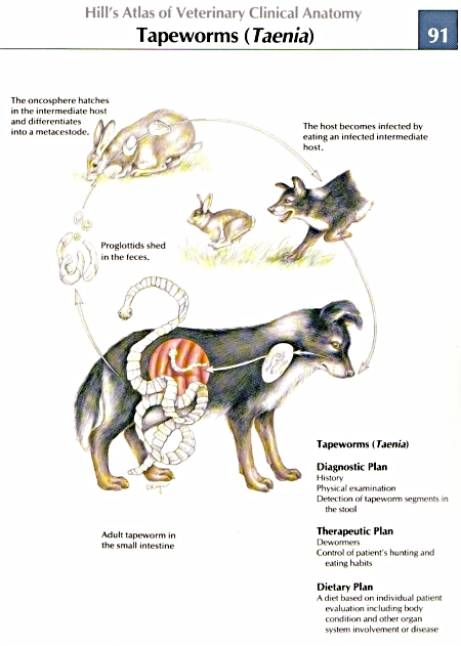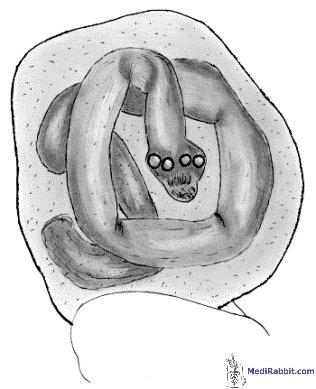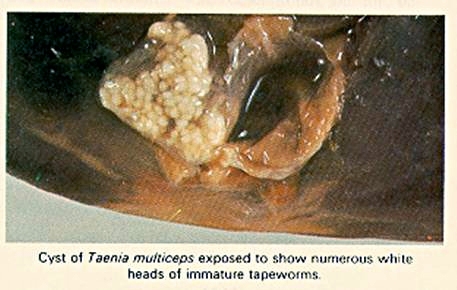Flat worms:
rabbit as an intermediate host
Esther van Praag,
Ph.D.
|
MediRabbit.com is
funded solely by the generosity of donors. Every
donation, no matter what the size, is appreciated and will aid in the
continuing research of medical care and health of rabbits. Thank you |
Warning: this
file contains pictures that may be distressing for some persons.
Taenia pisiformis
The
tapeworm Taenia pisiformis is a common parasite of carnivores like dogs,
foxes, and sometimes of cats. It is found all over the world, predominantly
in rural regions. The
development of the parasite occurs in two stages: 1.
An adult stage, as an adult parasite in the
definitive host, the dog. The parasite lives in the small intestine (duodenum
jejunum and ileum) of the
dog and may reach a length of 2 meters (about 79 inches). Mature segments of
the tapeworm (protoglottid) containing mature eggs are shed along with the
feces. 2.
An intermediate stage in an herbivorous host where
the larval stage is found (mesacestoide). Rabbit or other lagomorph species
may ingest the eggs while grazing contaminated grass.
www.powhatananimalhospital.com/disease/tapeworms2.jpg The
intermediate stage (mesacestoide) is characterized by the presence of bladder
like structure in the abdominal/peritoneal cavity and liver. This
intermediate larval stage is called Cysticercus pisiformis. The
development of the larva is blocked and they will survive in the bladder
structure. Viable tapeworm related cysts reach a size up to 2-3 cm in
diameter, rarely up to 8 cm large or more. Development into the adult stage can only occur after ingestion of the viscera of an infested rabbit by a dog, fox or cat. The development of the larva will continue into adults.
Richard
Hoop Blister-like mature cysticerci (green
arrows)containing a larva of the tapeworm Taenia pisiformis in the body
cavity of a rabbit.
Detail of a cyst, showing the larval taperworm Cysticercus
pisiformis surrounded by fluids. The
parasitic larvae use the hepatic portal vein to invade the liver of rabbits.
The migration phase of the larva is usually accompanied by focal
granulomatous hepatitis-like symptoms: inflammation of the liver, local
hepatocellular necrosis, and hepatic scaring if the condition becomes
chronic. A microscopic analysis of the tissue shows the presence of necrotic
tissue, blood, degenerative granulocytes, giant cells as well as mononuclear
cells. Fibroblastic transformation of the tissue may be present, and the
affected tissue will be replaced by connective tissue. After 15 to 30 days,
the larva will migrate to the hepatic parenchyma and form cysts. A
severe infestation can cause chronic extreme weakness or sudden death. Aberrant
migration is possible. Some of these cysts have been found in the peritoneal
fluids or in the lungs of a rabbit, filling almost all the cavity of the lung
and causing respiratory distress. Brain cysticercosis leads to seizures,
increased intracranial pressure, and altered mental status. On X-ray, there
are signs of hydrocephalus, aseptic meningitis and/or calcified cysts. CT
scanning and MRI enable to see the cysts definitively, often accompanied by
ring-enhancing lesions, or hydrocephalus. Since MRI does not show the calcified
pocket clearly, a contrasting dye administrated IV, can be used to visualize
the inflamed and destroyed regions better. As
long as there is no direct contact and ingestion of the cysts containing the
larva (unlikely in pet rabbits), no contamination is possible. Treatment
can be attempted with praziquantel. Multiceps serialis
This
parasitic worm is also referred to as Taenia serialis. As with Taenia
pisiformis, the development of the parasite has two stages: an
intermediate one in hares or wild rabbits, and an adult form in dogs and
cats. Its incidence in house rabbits in rare. In rabbits, cysts of Multiceps
serialis are essentially found in the subcutaneous tissues and muscle
mass. The cysts are elongated and the larva can easily be seen.
www.unbc.ca/nlui/wildlife_diseases/taenia_multiceps.htm
The
development stage is blocked at the cyst stage in rabbits. Maturation and
development into the adult stage will only occur after a dog or fox eats an
infested rabbit. The
risk of human contamination is possible, when direct contact with the cysts
and ingestion of the intermediate larva (e.g. hunted hares/rabbits and
contact with the digestive tract). With house rabbits, the risk of
contamination is close to zero. Acknowledgement
My gratitude goes to Prof. Richard Hoop (Institut für
Veterinärbakteriologie, University of Zurich) for the permission to use his
picture related to Taenia cysts in rabbits Further information:
Manning
et al. The biology of the laboratory rabbit. 2nd ed. London, UK,
1994. Maynard
A. Novlesky MA, Dyer
WG. Helminths of the Eastern Cottontail Rabbit, Sylvilagus floridanus,
from North Dakota, by © 1970 The University of Notre Dame. Pinto
RM, et al. Helminths of rabbits (Lagomorpha, Leporidae) deposited in the
Helminthological Collection of the Oswaldo Cruz Institute. Rev. Bras. Zool. 2004, v. 21, n. 3, pp. 599-604. Soltysiak Z, Bednarski M, Piekarska J. Wagrzyca
watroby królika. Medycyna Wet. 2007, 63:1255-1257. |
e-mail: info@medirabbit.com








